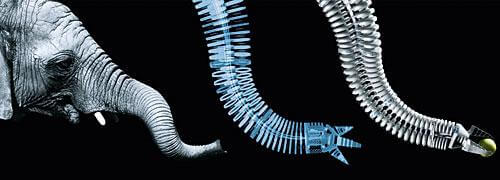Festo Turns Elephant’s Trunk into Awesome Robot Arm (video)

Share
Smart engineers copy ideas. Great engineers copy from nature. Festo's Bionic Handling Assistant is a robot arm modeled on an elephant's trunk, and it has all the supple flexibility of the original. Using hollow plastic chambers that change size with air pressure, the Bionic Handling Assistant can move through an incredible range of motion in three dimensions. It's designed to provide gentle forces, and to give when pushed, making it safe for working with humans in a working environment. The Bionic Handling Assistant is up for the prestigious German Future Award (Deutscher Zukunftspreis) and in celebration Festo has released a new video to highlight its skills. Watch the elephant inspired robot arm flex its way to fame in the clip below. It's amazing how life like it seems.
The Bionic Handling Assistant was developed through Festo's Bionic Learning Network, a coordinated group of industrial and academic research partners interested in bringing nature inspired concepts to robotics. They've produced some amazing looking bots that we've covered before such as penguins, flying fins, and muscle-like walls. Festo shows us a glimpse of a cool new bot, a jellyfish blimp, in their new video (2:18). However, all this biology inspired innovation is really only going to be useful if we can find the right applications. Opportunities for the Bionic Handling Assistant in medicine, manufacturing, and mechanical repair are shown below (~ 3:52), but I'm not sure Festo has really found a killer app for their product yet. We may need such elephant trunk robots to handle more weight at greater speed, and with more autonomy, before we really understand where they could be useful. I think elder home care would be a good bet.
For a bettter idea of how the pressurized air allows the Bionic Handling Assistant to move, here's a more detailed animation of the robot arm:
Be Part of the Future
Sign up to receive top stories about groundbreaking technologies and visionary thinkers from SingularityHub.


No matter where it eventually is applied, the Bionic Handling Assistant is a good sign that engineers have a lot to work with when mimicking natural structures. With all the humanoid robots running shuffling around it's important to remember that the primate form is only one of many successful architectures we should be copying. Robots that swim like fish, fly like insects, and form colonies like bees could all have crucial applications in the years ahead as we continue to explore the world. It will be interesting to see which animals the Festo Bionic Learning Network pursues next.
[image and video credit: Festo]
[source: Festo, Deutscher-Zukunftspreis (DE)]
Related Articles

These Robots Are the Size of Single Cells and Cost Just a Penny Apiece

In Wild Experiment, Surgeon Uses Robot to Remove Blood Clot in Brain 4,000 Miles Away

A Squishy New Robotic ‘Eye’ Automatically Focuses Like Our Own
What we’re reading
